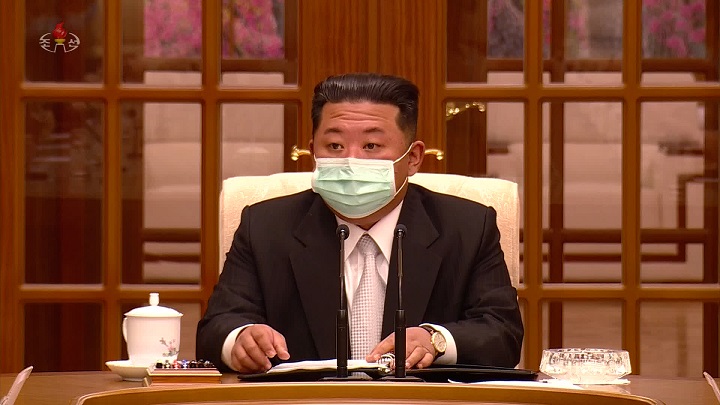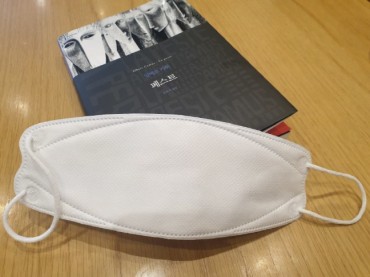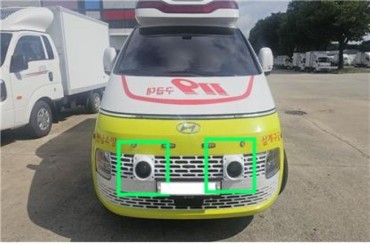
This photo, captured from North Korea’s Korean Central TV, shows leader Kim Jong-un wearing a face mask as he presides over a politburo meeting of the ruling Workers’ Party over the North’s first known case of COVID-19 in Pyongyang on May 12, 2022. (Yonhap)
SEOUL, June 11 (Korea Bizwire) — Just a month since disclosing a coronavirus outbreak, North Korea claims new infections are markedly slowing down, but the outside world raises a question about the credibility of a puzzling number of “fever” cases announced on a daily basis.
Others question how the country’s antivirus fight will affect the leadership of Kim Jong-un in the end amid a view that the regime seems to be using what Kim described as a “great disaster” to tighten his grip.
For more than two years, as the COVID-19 pandemic swept across the world crippling many lives and economies, the reclusive North claimed to be completely free of the virus, brushing off widespread suspicion over how a country bordering the pandemic-hit China had managed to stay safe.
That all changed a month ago.
To the surprise of many, Kim appeared in public on May 12 wearing a mask for the first time and admitted to the country’s first coronavirus infection. The North immediately declared a “maximum emergency” virus control system and went into a nationwide lockdown.
Like many other nations, Pyongyang has since released its own count of suspected coronavirus cases on a daily basis through its state-controlled media, citing data compiled by the “state emergency epidemic prevention headquarters.”

In this file photo released by the North’s Korean Central News Agency on May 17, 2022, North Korean health care officials carry out disinfection work at Pyongyang Station in the capital. (Yonhap)
Observers here, however, have doubts about those numbers.
Pyongyang claims its daily tally of “fevered persons” has gradually dropped to as low as under 50,000 this week, after reaching an all-time high of 392,920 on May 15, just days after its first omicron infection case was reported.
Questions linger over how the country with a population of 25 million, mostly unvaccinated, has managed to keep the highly transmissible omicron variant under control, at least ostensibly, in such a short period.
North Korea apparently lacks the testing capacity to confirm whether patients have tested positive with the coronavirus and has referred to such suspected patients as “feverish” or “fevered” cases.
It is also suffers from a shortage of coronavirus-related medicine. North Korea has instead ramped up the production of its traditional medicine made from herbs and plant roots, and advised its people to use home remedies, such as gargling with salt water.
Even more confusing is the country’s low coronavirus-related deaths in comparison with the number of suspected cases.
Pyongyang announced that the total number of fever cases since the outbreak had come to nearly 4 million as of early June but claims the total death toll stands at just 71, with a fatality rate of 0.002 percent.
Considering that South Korea, with a vaccination rate of more than 85 percent, experienced a far higher death rate of 0.13 percent, the death tally is unconvincing. Yet the North continues to assert that the pandemic is under control.
Late last month, leader Kim made a “positive evaluation” of the country’s antivirus efforts and said the pandemic was being controlled across the country as he presided over a politburo meeting.
The World Health Organization refuted his claim, saying it believes the pandemic in the North is actually getting worse, not better.

Choe Ryong-hae (C), chairman of North Korea’s Supreme People’s Assembly’s standing committee, inspects a pharmacy in Pyongyang amid the COVID-19 outbreak, in this undated photo released May 17, 2022, by the North’s official Korean Central News Agency. The military medical field of the People’s Army has been mobilized to supply medicine to pharmacies under the 24-hour service system, as the North has seen a surge in suspected coronavirus cases. (Yonhap)
Experts say the North could be using the outbreak as an opportunity to highlight Kim’s leadership in an effort to boost the people’s loyalty and strengthen internal unity.
“The North claims that the coronavirus has slowed down, but the statistics are hard to believe,” Yang Moo-jin, professor at the University of North Korean Studies, said.
“By claiming that it has quickly recovered from the pandemic, the North appears to be propagandizing the success of its own quarantine system and claiming it as Kim’s achievements.”
Since the outbreak, Kim has publicly rebuked officials for failing to respond properly to the COVID-19 outbreak in its early stages, a move that might help win the hearts and minds of ordinary people.
Meanwhile, it remains unclear whether the unpredictable Kim regime will seek to use the virus situation for diplomatic gains. South Korea and the U.S. have already stated their willingness for talks on offering vaccines and other humanitarian assistance.
(Yonhap)






